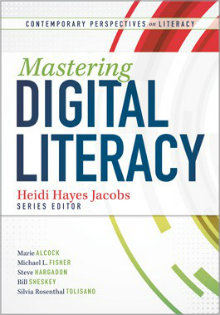Weighing Digital Literacy and Classroom Realities
Mastering Digital Literacy: Contemporary Perspectives on Literacy
Edited by Heidi Hayes Jacobs, Series Editor
(Solution Tree Press, 2014 – Learn more)

“Journeys aren’t taken in leaps; they are traveled in steps” (Jacobs 5).
In her introduction to this collection of essays, Heidi Hayes Jacobs describes the educator’s trip down the ever-changing path of technology. Some educators embrace all technological developments head-on, willing to test out the tricky terrain and forge a path for the more resistant.
Sometimes educators are not so much resistant as they are under-trained and under-supplied. Technology can certainly be a valuable classroom tool, but one must have the know-how as well as the appropriate equipment – in terms of quality and quantity – to enhance instruction.
In Mastering Digital Literacy, various authors share their positions on why mastering digital literacy and integrating digital literacy skills into their curriculum should be every teacher’s objective. The book is divided into the following chapters:
| Chap. | Title | Author(s) |
| 1 | Digital Masters: Becoming a Blogmaster, Annotexter, or Web Curator | Michael L. Fisher and Silvia Rosenthal Tolisano |
| 2 | Six Curriculum Actions for Developing Digitally Literate Learners | Heidi Hayes Jacobs |
| 3 | Notes From the Revolution: Peer-Driven Social Learning Communities | Steve Hargadon |
| 4 | Gaming as a Literacy: An Invitation | Marie Alcock |
| 5 | The Classroom Website: A Marketplace for Learning | Bill Sheskey and Marie Alcock |

More “considering” than “mastering”
On the flip side, if you are seeking a source that will walk you through the “how” of mastering digital literacy (as the title suggests), I would encourage you to keep on seeking. I work in a district that has provided its students with access to the latest technology for more than a decade. The high school in my district has been 1:1 for several years now.
As someone who is comfortable around technology and always willing to try new approaches if they will enhance my curriculum, I looked forward to reading this book for how it could help me become more comfortable with digital literacy. Instead, what I found were authors who talked a lot of “why” but not much about “how.”
Even in their justifications for inclusion of blogging, annotexting, curating, and gaming – among other skills said to be required to develop one’s digital prowess – what was glaringly absent was any research to support not only their claims that shifting to this model of instruction was crucial but, more importantly, evidence that doing so yields transfer of knowledge and academic growth.
While the authors have advanced degrees in the area of education, their arguments and examples do not read as if they are in touch with the reality of today’s classroom. They fail to adequately address the demands and time constraints of the current testing culture. They paint a picture of technology automatically engaging these digital natives because it is their language – without allowances for the classroom management issues that rear their ugly heads whether students are sitting in front of a computer screen or not.
And, perhaps most noticeable, there is little acknowledgment of students’ need to acquire foundational knowledge. Many of the ideas presented require students to have a solid content knowledge before they would be able to successfully complete, for example, the evaluation of a video game as it relates to a particular topic.
Three issues I would like to see addressed
I began writing this review nearly one year ago. In August 2014, I was preparing to enter a new school year, a year in which each middle school student would be provided with a district-issued device. After I finished reading this book, I took an inventory of my emotions. I acknowledged that if I submitted my review at that point in time, I might not be giving this whole “mastering digital literacy” thing a fair shot. Perhaps I needed to observe the dynamics of the 1:1 culture that would surely permeate my building, revisit the book after we had spent some time apart, and then try again.
Based on my academic year spent in the 1:1 digital world, I came away with three observations that were not addressed by the various authors contributing to this book:
- Constant access to technology creates unhealthy addictions, not increased academic engagement. Although the book does not explicitly focus on the necessity of 1:1, ready access to technology is critical to implementing the authors’ recommendations. In the past year, I have seen more students checked out than ever before. They have mastered the art of looking busy and switching screens in a way that made me question whether I had just seen a game…or not. The majority of students had an intrinsic desire to use technology as a means of avoiding work, not engaging more readily with learning. I wish I were speaking hyperbolically, but I am not.
- Digital native does not equal digital expert. I will never forget the day I was lamenting the lack of attention given to the pronoun “I” in students’ writing and its need for capitalization. Always. “But, Mrs. Grieb, if auto-correct doesn’t catch it, it’s not our fault!” they cried in response. As students began scrolling through their essays to look for this particular error, I introduced them to the “Find” function. Their minds were blown. Why had no one ever before taught them this trick? Why indeed. It is too often assumed that these 21st century students are born with digital skills grafted into their genetic makeup. But they aren’t. While the authors of this book may mean well, they make many assumptions about what students know and do not account for the time required to teach them the skills to use digital tools to the extent promoted along with teaching the required academic curriculum.
- Each student still learns differently. In Chapter 1, when defining literacy, Fisher and Tolisano question how long it will be until those literate by today’s standards – analog readers and writers – will be irrelevant and illiterate. Perhaps I am a traditionalist at heart, but preferring to read print or write an essay on paper should never preclude a student from being literate. On the contrary, I had students of all learning capabilities request to have materials printed out or to be able to handwrite an assignment instead of relying on the screen. This request did not make them illiterate. It made them cognizant of how they learn best.
Journeys are, in fact, traveled in steps. Whether you are well on the road to achieving digital mastery or still staring at the map, one step forward is still a step.
Sarah Grieb earned undergraduate degrees in English Literature and Spanish from Lycoming College and her M.Ed. in Curriculum and Instruction with an emphasis in Children’s Literature from the Pennsylvania State University. However, since 2004, her educational experience “has come through the teaching of hundreds of unique individuals in her 8th grade Language Arts classroom in the Central York School District (York, PA)” as well as raising three of her own future middle school students.


































